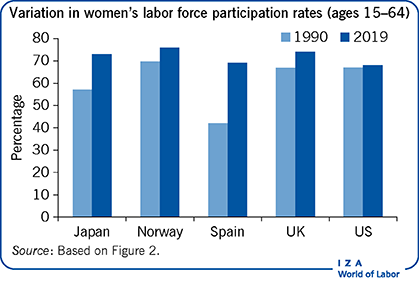Elevator pitch
Female labor force participation is mainly driven by the value of their market wages versus the value of their non-market time. Labor force participation varies considerably across countries. To understand this international variation, it is important to further consider differences across countries in institutions, non-economic factors such as cultural norms, and public policies. Such differences provide important insights into what actions countries might take to further increase women's participation in the labor market.

Key findings
Pros
Women’s economic activity outside the home translates into improved outcomes for girls and women (improved health, reduced domestic violence for women), and society as a whole (greater economic growth).
Women’s labor market activity—not just entry, but also long-term attachment—provides the path for women to participate in the top echelons of academia, industry, government, and the non-profit sector.
Family-friendly policies (e.g. family leave and childcare subsidies) encourage women’s labor force participation.
Cons
Rising educational attainment by women does not always translate into increased labor force participation rates.
While family-friendly policies may encourage women’s labor force participation, they may also create unintended “glass ceilings”, in other words, they may inhibit women’s advancement to the top levels of their professions.
It is difficult to discern if rising educational attainment causes increased labor force participation, or if women’s rising labor force participation rates spur them to undertake additional educational investments.